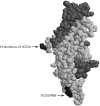Refocusing of B-cell responses following a single amino acid substitution in an antigen
- PMID: 11412304
- PMCID: PMC1783232
- DOI: 10.1046/j.1365-2567.2001.01242.x
Refocusing of B-cell responses following a single amino acid substitution in an antigen
Abstract
Intranasal immunization of BALB/c strain mice was carried out using baculovirus-derived human chorionic gonadotrophin (hCG) beta-chain, together with Escherichia coli heat-labile enterotoxin. Gonadotrophin-reactive immunoglobulin A (IgA) was induced in a remote mucosal site, the lung, in addition to a systemic IgG response. The extensive sequence homology with luteinizing hormone (LH) results in the production of LH cross-reactive antibodies when holo-hCG is used as an immunogen. In contrast to wild-type hCGbeta, a mutated hCGbeta-chain containing an arginine to glutamic acid substitution at position 68 did not induce the production of antibodies which cross-react with LH. Furthermore, the epitopes utilized in the B-cell response to the mutated hCGbeta shifted away from the immunodominant region of the parent wild-type molecule towards epitopes within the normally weakly immunogenic C terminus. This shift in epitope usage was also seen following intramuscular immunization of rabbits. Thus, a single amino acid change, which does not disrupt the overall structure of the molecule, refocuses the immune response away from a disadvantageous cross-reactive epitope region and towards a normally weakly immunogenic but antigen-unique area. Similar mutational strategies for epitope-refocusing may be applicable to other vaccine candidate molecules.
Figures





Similar articles
-
The human chorionic gonadotropin-beta arginine68 to glutamic acid substitution fixes the conformation of the C-terminal peptide.Mol Endocrinol. 2005 Jul;19(7):1803-11. doi: 10.1210/me.2004-0109. Epub 2005 Feb 17. Mol Endocrinol. 2005. PMID: 15718290
-
Mucosal inoculation of Lactobacillus expressing hCGbeta induces an anti-hCGbeta antibody response in mice of different strains.Methods. 2006 Feb;38(2):124-32. doi: 10.1016/j.ymeth.2005.09.014. Methods. 2006. PMID: 16414267
-
Epitopes of human chorionic gonadotropin and their relationship to immunogenicity and cross-reactivity of beta-chain mutants.Am J Reprod Immunol. 1998 Sep;40(3):210-4. doi: 10.1111/j.1600-0897.1998.tb00414.x. Am J Reprod Immunol. 1998. PMID: 9764366
-
The molecular relationship between antigenic domains and epitopes on hCG.Mol Immunol. 2016 Aug;76:134-45. doi: 10.1016/j.molimm.2016.06.015. Epub 2016 Jul 21. Mol Immunol. 2016. PMID: 27450517 Review.
-
Prion protein peptides as vaccines.Mini Rev Med Chem. 2009 Apr;9(4):470-80. doi: 10.2174/138955709787847903. Mini Rev Med Chem. 2009. PMID: 19356125 Review.
Cited by
-
Vaccines for immunological control of fertility.Reprod Med Biol. 2009 Dec 1;9(2):61-71. doi: 10.1007/s12522-009-0042-9. eCollection 2010 Jun. Reprod Med Biol. 2009. PMID: 29699331 Free PMC article. Review.
-
Engineering filamentous phage carriers to improve focusing of antibody responses against peptides.Vaccine. 2010 Mar 2;28(10):2174-2185. doi: 10.1016/j.vaccine.2009.12.059. Epub 2010 Jan 5. Vaccine. 2010. PMID: 20056188 Free PMC article.
-
Biased anti-idiotype response in rabbits leads to high-affinity monoclonal antibodies to biologics.MAbs. 2020 Jan-Dec;12(1):1814661. doi: 10.1080/19420862.2020.1814661. MAbs. 2020. PMID: 32887534 Free PMC article.
-
Single amino acid substitutions in the severe acute respiratory syndrome coronavirus spike glycoprotein determine viral entry and immunogenicity of a major neutralizing domain.J Virol. 2005 Sep;79(18):11638-46. doi: 10.1128/JVI.79.18.11638-11646.2005. J Virol. 2005. PMID: 16140741 Free PMC article.
-
Glycan Masking of Epitopes in the NTD and RBD of the Spike Protein Elicits Broadly Neutralizing Antibodies Against SARS-CoV-2 Variants.Front Immunol. 2021 Dec 2;12:795741. doi: 10.3389/fimmu.2021.795741. eCollection 2021. Front Immunol. 2021. PMID: 34925381 Free PMC article.
References
-
- Delves PJ, Lund T, Roitt IM. Can epitope-focused vaccines select advantageous immune responses? Mol Med Today. 1997;3:55–60. 10.1016/s1357-4310(96)20036-x. - DOI - PubMed
-
- Suhrbier A. Multi-epitope DNA vaccines. Immunol Cell Biol. 1997;75:402–8. - PubMed
-
- Roitt IM. Basic concepts and new aspects of vaccine development. Parasitol. 1989;98:S7–S12. - PubMed
Publication types
MeSH terms
Substances
LinkOut - more resources
Full Text Sources
Other Literature Sources
Miscellaneous

